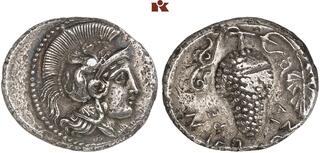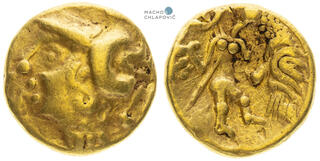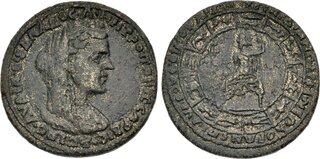Lot description:
CILICIA. SOLOI.
AR-Stater, 385/350 v. Chr.; 9,85 g. Athenakopf r. mit attischem Helm, Greif als Helmzier// Weintraube. SNG France 2, 174 (dort mit Gegenstempel); SNG Levante -.
Min. korrodiert, Schürfstelle auf dem Avers, sehr schön-vorzüglich/sehr schön
Exemplar der Auktion Hirsch Nachf. 189, München 1996, Nr. 338.
In der Sayar Collection gibt es eine umfängliche Sammlung von klassischen und hellenistischen Münzen der Stadt Soloi (Nr. 464-477), die – wenn man sie zu lesen versteht – die Geschichte der Stadt, die sie geprägt hat, erzählen. Soloi war als Heimatstadt des berühmten Dichters Arat und des bekannten Philosophen Chrysipp, die beide im 3. Jhdt. v. Chr. wirkten, jedem gebildeten Griechen bekannt. Beide sind auf kaiserzeitlichen Münzen abgebildet (Franke 2011). Trotz dieser Dichter und Denker stand die Bevölkerung im Ruf, ein fehlerhaftes Griechisch zu sprechen, das mit Verstößen gegen die Grammatik so gespickt war, dass man von Soloikismen sprach (Salmeri 2004). Vom klassischen oder hellenistischen Soloi, das 11 km westlich der heutigen türkischen Metropole Mersin bei Viranşehir (‹Ruinenstadt›) liegt, ist so gut wie nichts mehr zu sehen. Zahlreiche heute noch aufrechtstehende Säulen markieren eine römische Säulenstraße (Borgia 2004) und gehen auf die von Pompeius neubegründete Stadt zurück (Dreizehnter 1975, 239 f.; Ziegler 1993, 208 f.): Damals wurde Soloi in Pompeiopolis umbenannt. Der geniale römische Feldherr siedelte nach der Zerschlagung der kilikischen Piratenbanden jene Korsaren an, die wieder zu einem bürgerlichen Leben zurückfinden sollten.
Soloi geht neuesten Ausgrabungen zufolge bis in die hethitische Zeit zurück (R. Yağcı, Soli/Pompeiopolis kazıları 1999-2006). Möglicherweise kamen schon Mykener/Achäer, die während der Völkerwanderungszeit um 1200 v. Chr. von der Peloponnes in den östlichen Mittelmeerraum flohen, nach Soloi. Ihr Anführer soll der argivische Königssohn Amphilochos gewesen sein (Strabon XIV 5, 8 und 17). Auf einem Siedlungshügel der Vorzeit (Tell/Hüyük; vgl. Blumenthal 1963, 115 und 121) ließen sich im 7. Jhdt. v. Chr. Siedler von Argos nieder und gründeten dort einen griechischen Stützpunkt, wenn nicht gar eine griechische Stadt (Polis). Bei Soloi beginnen die Taurosberge vom Meer zurückzutreten; eine zunehmend breiter werdende Ebene schiebt sich vor sie. Dort konnten die Griechen aus Argos Acker- und Weinbau betreiben. Nicht ohne Grund erscheint auf den Münzen von Soloi immer wieder eine Weintraube. Die Siedler aus Argos brachten auch führende Gottheiten mit, insbesondere Athena Polias, die auf dem Burgberg von Argos (Larissa) ihr Heiligtum hatte, und die Dioskuren, die ebenfalls in Argos einen Tempel besaßen und mit einer hochberühmte Statuengruppe geehrt wurden. Im 6. Jhdt. kamen Siedler von Lindos auf Rhodos hinzu (Strabon XIV 5, 8 und 17). Sie brachten den Kult der Athena Lindia mit. Ein Priester der argivischen und der lindischen Athena ist auf einer kaiserzeitlichen Inschrift, die in Soloi gefunden wurde, bezeugt (Beaudouin – Pottier 1880). Die Bedeutung des Athena-Kultes wird durch die Münzen von Soloi massiv unterstrichen: Sehr viele von ihnen tragen Athena-Darstellungen. Ebenfalls auf argivischen Ursprung weisen die Dioskurenkappen (Piloi) (Nr. 475) mit Sternen. Der Helioskopf (Nr. 476) evoziert die alten Verbindungen mit Rhodos. Das Beizeichen Eule (Nr. 473) weist auf die athenische Athena. Da die Bürger von Soloi auch den Athener Solon als einen ihrer Stadtgründer ansahen (Diogenes Laertios I 50 f.: Salmeri 2004, 200), könnte die athenische Athena mit dieser Tradition in Verbindung zu bringen sein.
Von der Blüte der Stadt zeugt ein Stater aus dem 4. Jhdt. v. Chr. (Nr. 465), der mit einem schönen Athenakopf geschmückt ist und die Signatur des Stempelschneiders Apaturios (Berthold 2008, 257 f.) trägt. Offenbar leistete die Stadt sich einen namhaften Künstler für das Design ihrer Münzen. [JN]
The Sayar Collection comprises an extensive ensemble of Classical and Hellenistic coins from the city of Soloi (Nos. 464-477), which – if you know how to read them – tell the story of the city that minted them. Soloi was the hometown of the famous poet Arat and the well-known philosopher Chrysipp, both of whom were active in the 3rd century BC and well known to every educated Greek. Both are depicted on coins from the imperial period (Franke 2011). Despite these famous sons of the city, the population had a reputation for speaking a flawed Greek riddled with grammatical mistakes, which were referred to as soloicisms (Salmeri 2004).
Above the ground, virtually nothing remains of Classical and Hellenistic Soloi, which lies 11 km west of today's Turkish metropolis of Mersin near Viranşehir ('Ruined city'). The numerous columns still standing upright today mark a Roman colonnaded street (Borgia 2004) and date back to the city newly founded by Pompey (Dreizehnter 1975, 239 f.; Ziegler 1993, 208 f.): At that time Soloi was renamed Pompeiopolis. After the destruction of the Cilician pirate gangs, the ingenious Roman general and politician domiciled those pirates there, as he considered them to be capable of finding their way back to an orderly civic life.
According to the latest excavations, Soloi dates back to the Hittite period (Yağcı 2007). It is possible that Mycenaeans/Achaeans, who fled from the Peloponnese to the eastern Mediterranean during the Migration Period around 1200 BC, came to Soloi. Their leader is said to have been the Argive king's son Amphilochos (Strabon XIV 5, 8 and 17). Settlers from Argos settled on a prehistoric settlement mound (Tell/Hüyük; cf. Blumenthal 1963, 115 and 121) in the 7th century BC and founded a Greek base there, if not a Greek city (polis). At Soloi, the Tauros Mountains begin to recede from the sea, with an increasingly broad plain stretching out in front of the mountains. The Greeks from Argos were able to farm and cultivate vines there. It is not without reason that a bunch of grapes repeatedly appears on the coins of Soloi. The settlers from Argos also brought tutelary deities with them, in particular Athena Polias, who had her sanctuary on the castle hill of Argos (Larissa), and the Dioscuri, who also had a temple and highly famous statues in Argos. In the 6th century BC, settlers arrived from Lindos – one of the three old cities on Rhodes (Strabon XIV 5, 8 and 17). They brought the cult of Athena Lindia to Soloi. An imperial inscription found in Soloi attests to the existence of a priest of Argivian and Lindian Athena (Beaudouin – Pottier 1880). The importance of the cult of Athena is massively underlined by the coins of Soloi: many of them bear depictions of Athena. The Dioscuri caps (piloi) with stars should also be associated with the city's Argivian origins. The head of Helios evokes the ancient connections with Rhodes. As the citizens of Soloi also regarded Athenian Solon as one of their city founders (Diogenes Laertios I 50 f.: Salmeri 2004, 200), Athena's owl may be associated with this tradition.
Of particular interest is a bronze piece from the 2nd/1st century BC (No. 473). It shows a gorgoneion on the obverse and a woman riding a bull on the reverse. Amphilochos is said to have dedicated a bowl with a gorgoneion to the sanctuary of Athena Lindia on Rhodes (Higbie 2003, 38 f. and 126 f.). The Gorgon motif may also have something to do with the fact that, according to mythical traditions, the Argive hero Perseus is said to have beheaded the Gorgo in Cilicia. The bull-riding woman is interpreted as Astarte/Aphrodite or Europa. However, in a Greek city of that period, she was probably rather seen as Europa than as the oriental goddess. A stater from the 4th century BC (No. 465) bears witness to the city's heyday. It is decorated with a beautiful Athena's head and bears the signature of die-cutter Apaturios (Berthold 2008, 257 f.). The prosperous city evidently employed a renowned artist to design its coins. [JN]
Estimate: 500 EUR |  |












